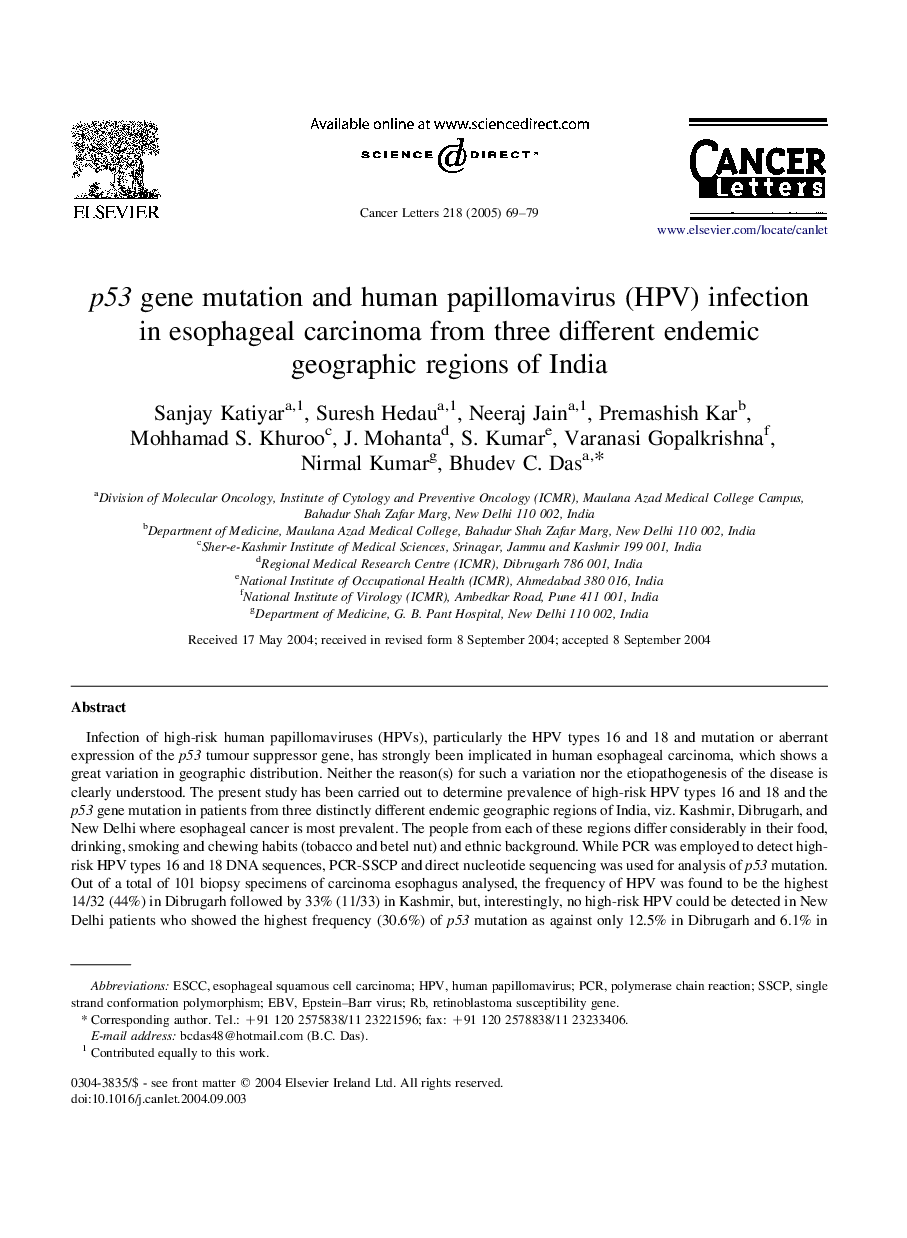| کد مقاله | کد نشریه | سال انتشار | مقاله انگلیسی | نسخه تمام متن |
|---|---|---|---|---|
| 10900587 | 1084653 | 2005 | 11 صفحه PDF | دانلود رایگان |
عنوان انگلیسی مقاله ISI
p53 gene mutation and human papillomavirus (HPV) infection in esophageal carcinoma from three different endemic geographic regions of India
دانلود مقاله + سفارش ترجمه
دانلود مقاله ISI انگلیسی
رایگان برای ایرانیان
کلمات کلیدی
SSCPESCCSingle strand conformation polymorphism (SSCP)EBV - اپشتین بار ویروسp53 mutation - جهش p53polymerase chain reaction - واکنش زنجیره ای پلیمرازPolymerase Chain Reaction (PCR) - واکنش زنجیره ای پلیمریزاسیون (PCR)PCR - واکنش زنجیرهٔ پلیمرازEpstein–Barr virus - ویروس Epstein-BarrHuman papillomavirus - ویروس پاپیلوم انسانیHuman papillomavirus (HPV) - ویروس پاپیلومای انسانی (HPV)HPV - ویروس پایپلوم انسانیSingle strand conformation polymorphism - پلیمورفیسم یکپارچگی رشتهEsophageal squamous cell carcinoma - کارسینوم سلول سنگفرشی مریEsophageal squamous cell carcinoma (ESCC) - کارسینوم سلول سنگفرشی مری (ESCC)
موضوعات مرتبط
علوم زیستی و بیوفناوری
بیوشیمی، ژنتیک و زیست شناسی مولکولی
تحقیقات سرطان
پیش نمایش صفحه اول مقاله

چکیده انگلیسی
Infection of high-risk human papillomaviruses (HPVs), particularly the HPV types 16 and 18 and mutation or aberrant expression of the p53 tumour suppressor gene, has strongly been implicated in human esophageal carcinoma, which shows a great variation in geographic distribution. Neither the reason(s) for such a variation nor the etiopathogenesis of the disease is clearly understood. The present study has been carried out to determine prevalence of high-risk HPV types 16 and 18 and the p53 gene mutation in patients from three distinctly different endemic geographic regions of India, viz. Kashmir, Dibrugarh, and New Delhi where esophageal cancer is most prevalent. The people from each of these regions differ considerably in their food, drinking, smoking and chewing habits (tobacco and betel nut) and ethnic background. While PCR was employed to detect high-risk HPV types 16 and 18 DNA sequences, PCR-SSCP and direct nucleotide sequencing was used for analysis of p53 mutation. Out of a total of 101 biopsy specimens of carcinoma esophagus analysed, the frequency of HPV was found to be the highest 14/32 (44%) in Dibrugarh followed by 33% (11/33) in Kashmir, but, interestingly, no high-risk HPV could be detected in New Delhi patients who showed the highest frequency (30.6%) of p53 mutation as against only 12.5% in Dibrugarh and 6.1% in Kashmir. The difference in the frequency of p53 mutation between the three regions was statistically highly significant (0.018). Out of a total of 21 nucleotide alterations observed, 12 missense, five frameshift and four were silent changes. The p53 exon 7 appears to be the 'hot-spot' for esophageal cancer as it alone was responsible for more than 76% (13/17) of mutations and more than 95% (20/21) of the patients with p53 mutation were smokers. The results demonstrate differential distribution of HPV infection and p53 mutation in esophageal cancer from different geographic regions of India and this could be due to variation in diet, drinking, and tobacco habit, including ethnic, socio-cultural and genetic variation.
ناشر
Database: Elsevier - ScienceDirect (ساینس دایرکت)
Journal: Cancer Letters - Volume 218, Issue 1, 31 January 2005, Pages 69-79
Journal: Cancer Letters - Volume 218, Issue 1, 31 January 2005, Pages 69-79
نویسندگان
Sanjay Katiyar, Suresh Hedau, Neeraj Jain, Premashish Kar, Mohhamad S. Khuroo, J. Mohanta, S. Kumar, Varanasi Gopalkrishna, Nirmal Kumar, Bhudev C. Das,